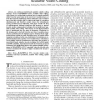Free Online Productivity Tools
i2Speak
i2Symbol
i2OCR
iTex2Img
iWeb2Print
iWeb2Shot
i2Type
iPdf2Split
iPdf2Merge
i2Bopomofo
i2Arabic
i2Style
i2Image
i2PDF
iLatex2Rtf
Sci2ools
TCSV
2008
2008
In-Scale Motion Compensation for Spatially Scalable Video Coding
In existing pyramid-based spatially scalable coding schemes, such as H.264/MPEG-4 SVC (scalable video coding), video frame at a certain high-resolution layer is mainly predicted either from the same frame at the next lower resolution layer, or from the temporal neighboring frames within the same resolution layer. But these schemes fail to exploit both kinds of correlation simultaneously and therefore cannot remove the redundancies among resolution layers efficiently. This paper extends the idea of spatiotemporal subband transform and proposes a general in-scale motion compensation technique for pyramid-based spatially scalable video coding. Video frame at each high-resolution layer is partitioned into two parts in frequency. Prediction for the lowpass part is derived from the next lower resolution layer, whereas prediction for the highpass part is obtained from neighboring frames within the same resolution layer, to further utilize temporal correlation. In this way, both kinds of corre...
Related Content
| Added | 15 Dec 2010 |
| Updated | 15 Dec 2010 |
| Type | Journal |
| Year | 2008 |
| Where | TCSV |
| Authors | Ruiqin Xiong, Jizheng Xu, Feng Wu |
Comments (0)

